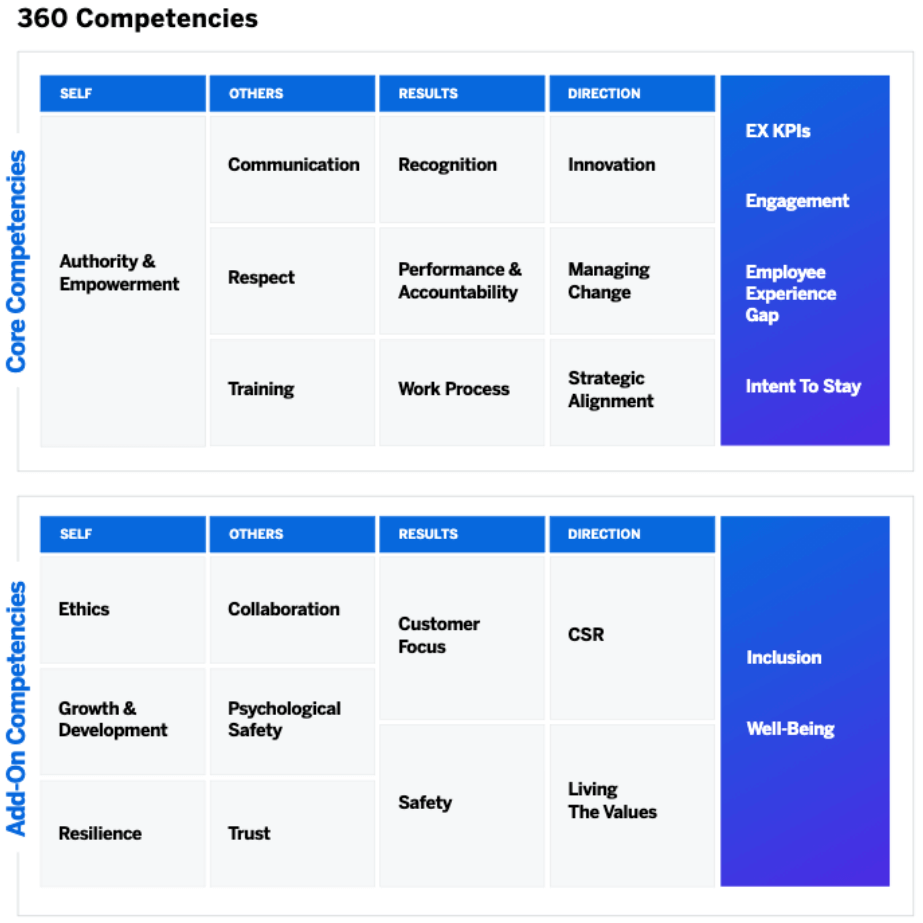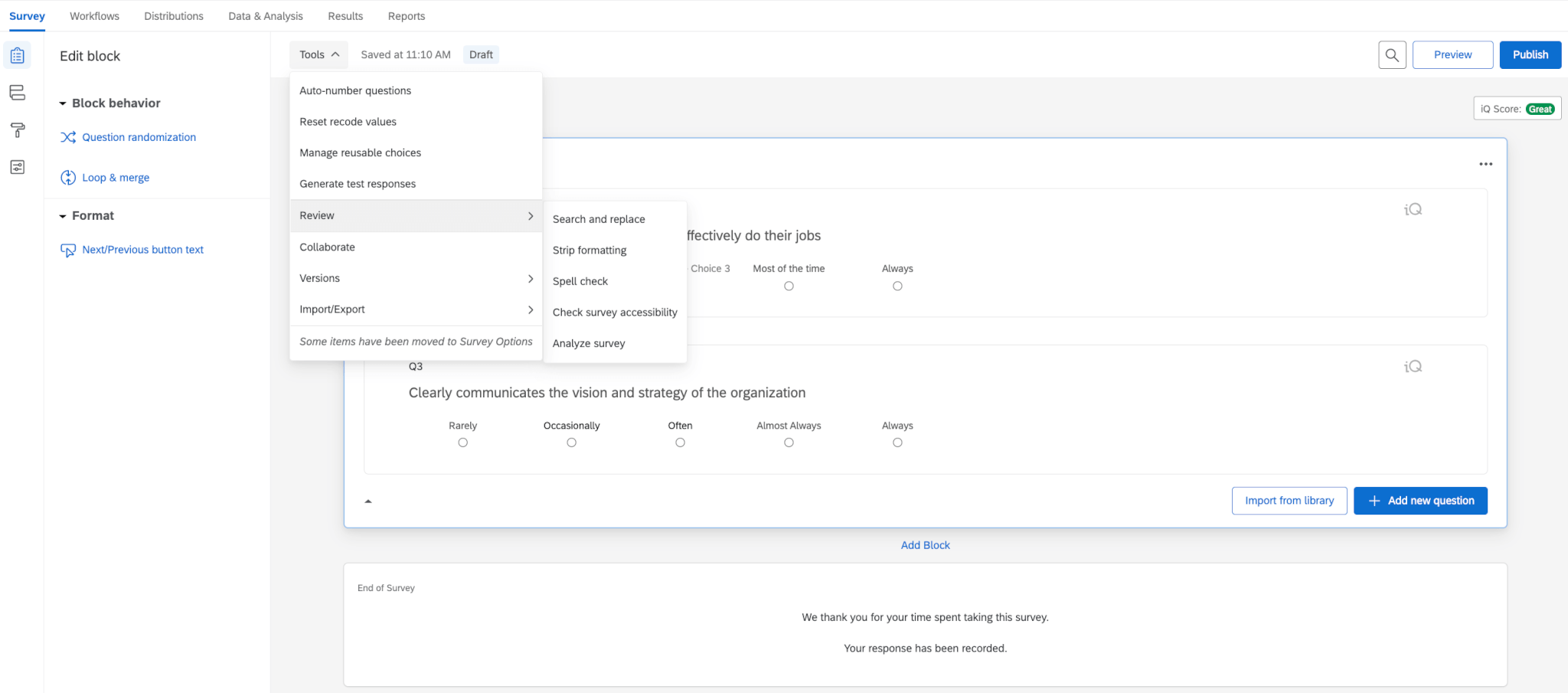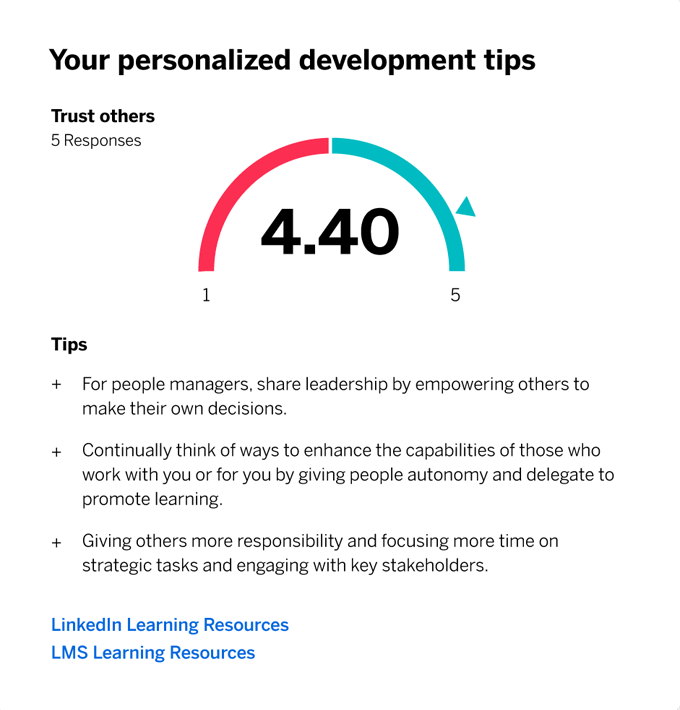Employee development has never been more critical. New business models, increased automation, greater digitalisation, self learning, and remote work are all driving a fundamental shift in the skills and behaviours employees need to be successful.
And it’s not just leaders who need to develop new behaviours and skills to adapt to the future of work. All employees, including people managers and individual contributors, need to understand which skills and behaviours will have the most impact on their careers – and your organisation.
If you’re looking to get started using 360-degree feedback to develop your people, you’ve come to the right place. At Qualtrics, we strongly recommend that a 360 assessment be used purely for developmental purposes. And so, we’ve outlined how a 360 review program works, its benefits, and the steps you can take to get started designing a 360 program that will help you develop talent at your organisation.
What is a 360-degree review process?
A true 360-degree review program collects constructive feedback from a number of different people across all of the roles the employee works closely with, including managers, peers, direct reports, vendors, and customers, and presents them to the employee in a transparent way.
This type of varied feedback can be extremely valuable for employee development and can act as a powerful feedback tool. It delivers well-rounded feedback to individual employees that covers all the aspects of their role.
Why? Because true 360s give employees actionable insight into their behaviours and performance, which in turn, drives development and behaviour change.
How effective is 360-degree feedback?
360-degree feedback is a common approach that many organiSations use to combat the issues inherent in traditional performance reviews, such as manager bias and a lack of representation of an employee’s true performance. However, at Qualtrics, we don’t recommend using 360 feedback in employee performance evaluations. Instead, we recommend its use to help people positively, through development.
360 feedback is effective for developing your people in the following ways:
- Increasing employee self-awareness
- Creating a balanced view of the organisation as well as the broader growth and development strategy and expectations
- Identifying strengths and weaknesses in employee skill sets in order to build or improve on them
- Building a culture of feedback that allows for open communication
- Ensuring successful succession planning
- Generating an optimal flow of identifying training opportunities
Taking action on 360-degree feedback
Whether your employee receives mainly positive feedback, negative feedback or a mix of the two, what counts is being able to use it constructively. Without the right positive emphasis from managers and senior leaders, the 360-degree feedback process can be stressful, both for the person providing feedback and the one being evaluated. Likewise, both downward feedback – where managers give feedback about a direct report – and upward feedback, which may come from junior reporting staff members, can create their own types of tension thanks to the different power dynamics involved.
To help counteract this, maintain an emphasis on the results of the process, and provide a better understanding of the type of action the employee and their manager can take as a result. This will help evaluators to understand the scope of their task and the kind of input they should be providing. It will also help set the rated employee’s mind at rest.
Provided the review process is managed well, the feedback the employee gets from multiple peers will tie in with what they already know. Their own strengths and weaknesses, explored through self-evaluation with their manager, will not be a surprise to them.
However, hearing this information again doesn’t make 360 feedback a redundant exercise. While an employee may have a general sense of their strengths and challenges, hearing the same feedback from multiple people can help clarify the knowledge and galvanise the employee to take action.
10 steps to designing an effective 360-degree review program
Qualtrics 360 Development helps you develop all levels of talent across your organisation to close talent gaps and accelerate organisational performance improvement.
Following this seven-step framework, you will be able to successfully deliver an actionable development program that empowers your employees to quickly identify and close their talent gaps so they can become better leaders and drive greater business impact.
Step 1. Set clear goals
It’s critically important to identify clear goals when starting a 360 assessment program for leaders, managers, or individual contributors. As mentioned above, we strongly recommend that a 360 assessment be utilised purely for developmental purposes, rather than as a tool for performance reviews or performance management.
Here’s why: When peer feedback directly influences an employee’s work performance ratings, pay, or promotion, it can negatively affect the fidelity of responses from raters or even be viewed as a political tool.
Peer feuds can be created by feedback mechanisms and a phenomenon known as “sandbagging” can take over where self-interests trump the investment in developing others. The reason for this is often the scarcity of promotion opportunities and rewards in organisations.
However, when the purpose of a 360 program is purely developmental, such conflicts of interest can be avoided.
Step 2. Train raters
Before getting started with 360 assessments, we recommend that you provide adequate training for anyone who will be involved in the review process. Proper training ensures consistency in how feedback is provided. It also helps raters to focus on the desired outcomes of the process – which should be transparent to everyone involved.
When raters are trained to operate from a standpoint of providing feedback that will positively impact a person’s growth, the exercise can create positive momentum for engagement, productivity, and better, more honest relationships with colleagues, leaders, and direct reports.
Step 3. Focus on natural strengths
We recommend a strengths-based approach to development. This means the primary focus is on an individual’s natural strengths rather than areas that do not come most naturally.
Focusing coaching on only developmental areas will give only incremental results, while focusing on people’s natural talents can provide accelerated growth. According to Gallup, a strengths-based approach to employee development coaching can result in 7%-23% higher employee engagement, an 8%-18% increase in performance, and 20% – 73% reduction in attrition.
Step 4. Communicate through managers and leaders
Wherever possible in the process, involve managers and leaders to convey clearly what is being asked of their teams. Encourage them to spend time with each of their employees through both formal and informal check-ins to make sure there is clarity on the purpose of the 360 development process and that they understand their role in making it work.
Likewise, managers must be supported and informed in advance about how to communicate the feedback results by specifically focusing on desired behaviours on the job. It’s also important to coach them on setting behavioural goals for their team members while setting up the program.
Step 5. Create buy-in and trust in the 360 development program
It will be critical to engage senior leader champions for a successful 360 development program. Take the time to make the business case for 360 degree development. If necessary, reiterate the importance of feedback and underline how it helps to address issues like the growing employee skills gap, high employee mobility and employee engagement.
After all, many employees consider development one of the top benefits provided by employers. Our 2021 EX trends report showed that having good opportunities for learning and development was a key driver of employee engagement, a finding that’s remained consistent over many years.
To promote confidence and trust at all levels, stress the need for clarity of roles. Hold all stakeholders accountable for their roles (Subjects, Managers, Evaluators) while clarifying what is expected of each of them.
Step 6. Know what to ask and how to ask it
Now that you’ve laid the groundwork, it’s time to start designing your 360 feedback program. Ideally, your 360 assessments should not exceed 30 to 40 total items to avoid survey fatigue. Keep in mind that a rater could be providing feedback to multiple employees.
Also note that no more than 8-10 competencies should be included in the assessment. This helps employees understand the most critical competencies to their success in the role.
Learn more about how our new 360 Development framework exemplifies this approach
Here are examples of 360 competencies that you might want to include in your assessments:

As for rating scales, we encourage you to use frequency scales (Rarely > All the time) instead of “agree or disagree” scales. This will help evaluators focus on the consistency of important behaviours. If you are using open text items, phrase them in a way that leads direct evaluators to identify concrete examples of demonstrated behaviours or provide actionable feedback for improvement.
Here are some other helpful tips for choosing the right items to ask about in your 360 assessment.
| Do: | Don’t: |
| Focus your question on a single behaviour | Focus on multiple behaviours (double/triple barrelled) |
| Start with an action verb (e.g., motivates, listens, and so on.) | Include jargon or overly technically language |
| Capture an important aspect of a key competency | Include too many/unnecessary adverbs (e.g., efficiently, effectively) |
| Ensure the item can be acted upon if identified as an opportunity/weakness | Ask questions that are too technical or hard to understand |
| Ask questions that match the rating scale | Ask anything that might be culturally biased |
| Measure related competencies only | Loosely or fail to measure an important competency |
Step 7. Personalise the 360 development program to your organisation
One of the biggest advantages of using our 360 Development solution is that you can design a program by and for your organisation. You can use your own competency model, an external consulting model, or a hybrid of the two. The 360 Development solution affords the flexibility to ask exactly what is required for the organisation.

With our technology and services, you can customise your survey as well as your internal communications, such as invites, reminders, and more. Your 360 feedback program should also consider if different competencies and items need to be asked at different organisational levels and roles.
To offer a more seamless experience to your employees, we also recommend that your feedback programs be directly linked to your talent management processes so that the employees can act on the feedback and development ideas provided by the assessment.
Ultimately, 360 programs should be treated like two-way communication where the organisation is highlighting the competencies that are critically important to the culture and employees can see how they are doing against the criteria.
Step 8. Connect your 360-degree feedback with your EX Management program
The data generated as part of 360-degree feedback can take on new meaning and context when you combine it with your wider employee experience program.
Data signals around key drivers of employee experience, such as intent to stay, employee engagement and psychological safety, can prompt leaders and senior managers to explore potential development opportunities by conducting 360 development reviews. This can help both with the ‘why’ of what’s happening, and the ‘how’ of finding solutions through actionable feedback.
Even when a 360 review is not prompted by changes to EX signals, the two can still be connected. Constructive feedback from the review process can be combined with insights from employee listening to help leaders gain a deeper understanding of how employees think and feel about the organisation.

Step 9. Give your employees autonomy over their development
The purpose of employee development is to make sure employees are performing to the best of their abilities and fully realising their professional potential. This is most likely to happen when it’s a shared goal that employer and employee are equally invested in. Performance improvement should never be a matter of micromanagement or mistrust.
That’s why it’s important to give employees ownership over their feedback, delivered in personalised reports that empower them to improve. With the right tools in place, peer appraisal data can be aggregated into a clear and useful personal tip sheet for each employee, and connected to self-service learning resources and other development tools that help every employee regularly invest in their own progress.
Step 10. Follow up
As Jack Zenger and Joseph Folkman noted in the Harvard Business review, a round of 360 reviews can amount to no more than a waste of time and money if they are done once and then forgotten about. Your 360 degree process should be integrated with an ongoing development plan that involves regular and specific follow-ups with managers and possibly HR professionals too.
Refine your approach to 360-degree feedback
With our guide to 360-degree feedback best practices, leverage research-backed frameworks and proven approaches to effectively measure employee skills and attributes. This sample template will ensure your multi-rater feedback assessments deliver actionable, well-rounded feedback that helps employees grow.
You’ll find out more about:
- The 10 key elements of a successful 360 program
- Sample messaging and rating scales
- Questions you can use in 360 assessments
- How Qualtrics can enhance your employee experiences at scale
Take it further
Find examples and templates in the 360 Feedback Best Practices